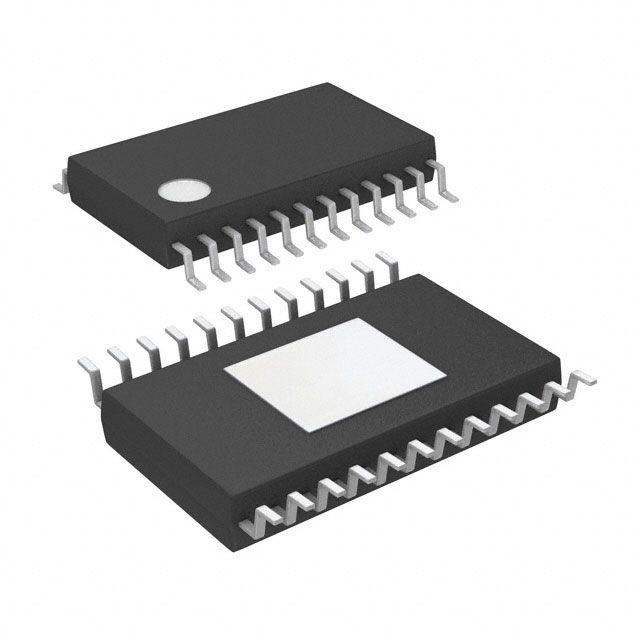LTC3862IFE#PBF
Product Overview
Category: Integrated Circuit (IC)
Use: Power Management
Characteristics: - High Efficiency - Wide Input Voltage Range - Synchronous Buck Controller - Adjustable Output Voltage - Current Limit Protection
Package: 16-Lead TSSOP
Essence: The LTC3862IFE#PBF is a high-performance synchronous buck controller IC used for power management applications. It offers a wide input voltage range and adjustable output voltage, making it suitable for various power supply designs.
Packaging/Quantity: The LTC3862IFE#PBF is available in a 16-Lead Thin Shrink Small Outline Package (TSSOP). It is typically sold in reels of 2500 units.
Specifications
- Input Voltage Range: 4V to 38V
- Output Voltage Range: 0.6V to VIN
- Switching Frequency: Up to 1MHz
- Maximum Duty Cycle: 90%
- Quiescent Current: 50µA
- Operating Temperature Range: -40°C to 125°C
Pin Configuration
The LTC3862IFE#PBF has the following pin configuration:
- VCC - Power Supply Input
- GND - Ground
- FB - Feedback Voltage Input
- SS - Soft-Start Control
- SYNC - External Clock Synchronization
- RT - Oscillator Frequency Setting
- COMP - Compensation Node
- ITH - Current Sense Threshold
- SW - Switch Node
- PGND - Power Ground
- BOOT - Bootstrap Capacitor Connection
- LX - Inductor Connection
- VOUT - Output Voltage
- EN - Enable Control
- OVLO - Overvoltage Lockout
- UVLO - Undervoltage Lockout
Functional Features
- High Efficiency: The LTC3862IFE#PBF offers high efficiency due to its synchronous buck controller architecture.
- Adjustable Output Voltage: The output voltage can be easily adjusted using the feedback voltage input (FB) pin.
- Current Limit Protection: The IC includes current limit protection to prevent excessive current flow.
Advantages and Disadvantages
Advantages: - Wide input voltage range allows for versatile power supply designs. - High efficiency results in reduced power losses. - Adjustable output voltage provides flexibility in various applications. - Current limit protection ensures safe operation.
Disadvantages: - Limited availability of alternative models with similar specifications. - Higher cost compared to non-synchronous buck controllers.
Working Principles
The LTC3862IFE#PBF operates as a synchronous buck controller, converting a higher input voltage to a lower output voltage. It utilizes pulse-width modulation (PWM) to regulate the output voltage. The feedback voltage input (FB) pin is used to set the desired output voltage. The IC also includes various protection features such as overvoltage lockout (OVLO) and undervoltage lockout (UVLO) to ensure safe operation.
Detailed Application Field Plans
The LTC3862IFE#PBF can be used in a wide range of power management applications, including but not limited to: - DC-DC converters - Power supplies for industrial equipment - Automotive electronics - Telecommunications systems - Battery charging circuits
Detailed and Complete Alternative Models
While there are limited alternative models with identical specifications, some alternative buck controller ICs that offer similar features include: - LT8610ABEMSE#PBF - LT8611ABEMSE#PBF - LT8612ABEMSE#PBF
These alternatives provide comparable performance and can be considered as substitutes for the LTC3862IFE#PBF in certain applications.
In conclusion, the LTC3862IFE#PBF is a high-performance synchronous buck controller IC used for power management applications. Its wide input voltage range, adjustable output voltage, and various protection features make it suitable for a variety of applications. While alternative models are limited, there are some viable substitutes available in the market.
Lista 10 Vanliga frågor och svar relaterade till tillämpningen av LTC3862IFE#PBF i tekniska lösningar
Sure! Here are 10 common questions and answers related to the application of LTC3862IFE#PBF in technical solutions:
Q: What is LTC3862IFE#PBF? A: LTC3862IFE#PBF is a high-performance synchronous step-down DC/DC controller IC manufactured by Linear Technology (now part of Analog Devices). It is designed for use in various power supply applications.
Q: What is the input voltage range supported by LTC3862IFE#PBF? A: The input voltage range supported by LTC3862IFE#PBF is typically between 4.5V and 38V.
Q: What is the output voltage range that can be achieved using LTC3862IFE#PBF? A: The output voltage range that can be achieved using LTC3862IFE#PBF depends on the external components used in the circuit. It can support output voltages as low as 0.6V.
Q: What is the maximum output current that LTC3862IFE#PBF can handle? A: LTC3862IFE#PBF can handle a maximum output current of up to 20A, depending on the design and thermal considerations.
Q: Does LTC3862IFE#PBF require an external MOSFET for operation? A: Yes, LTC3862IFE#PBF requires an external N-channel MOSFET for operation. The choice of MOSFET depends on the desired output current and voltage.
Q: Can LTC3862IFE#PBF operate in a synchronous rectification mode? A: Yes, LTC3862IFE#PBF supports synchronous rectification, which improves efficiency by reducing power losses.
Q: Is LTC3862IFE#PBF suitable for battery-powered applications? A: Yes, LTC3862IFE#PBF is suitable for battery-powered applications as it has a wide input voltage range and can efficiently regulate the output voltage.
Q: Does LTC3862IFE#PBF have built-in protection features? A: Yes, LTC3862IFE#PBF has various built-in protection features such as overvoltage protection (OVP), overcurrent protection (OCP), and thermal shutdown.
Q: Can LTC3862IFE#PBF be used in automotive applications? A: Yes, LTC3862IFE#PBF can be used in automotive applications as it meets the necessary requirements for automotive-grade components.
Q: Are there any application notes or reference designs available for LTC3862IFE#PBF? A: Yes, Analog Devices provides application notes and reference designs for LTC3862IFE#PBF on their website. These resources can help with the implementation of the IC in various technical solutions.
Please note that the answers provided here are general and may vary depending on specific design considerations and requirements. It is always recommended to refer to the datasheet and relevant documentation for accurate information.


